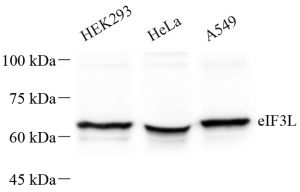Anti-eIF3L Rabbit pAb (100 μl)
| Reactivity: | H |
| Applications: | WB |
| Host Species: | Rabbit |
| Clonality: | Polyclonal |
| Full Name: | eIF3L rabbit polyclonal |
| Gene Name: | Eukaryotic translation initiation factor 3 subunit L |
| Synonyms: | eIF3l, Eukaryotic translation initiation factor 3 subunit 6-interacting protein, EIF3L, EIF3EIP, HSPC021, HSPC025, MSTP005 |
| Immunogen: | Recombinant protein corresponding to Mouse eIF3L |
| Isotype: | IgG |
| Purity: | Affinity purification |
| Predicted MW. | 67 kDa |
| Observed MW. | 67 kDa |
| Uniprot ID: | Q9Y262 |
Product Usage Information
| Applications | Species | Dilution | Positive Tissue |
| WB | Human | 1: 500-1: 1000 | HEK293, Hela, A549 |
Background
The eIF3L is a component of the eukaryotic translation initiation factor 3 (eIF-3) complex, which is required for several steps in the initiation of protein synthesis. The eukaryotic initiation factor-3 (eIF3) scaffolding structure function to control the assembly of the 40S ribosomal subunit. Association of eIF3 proteins with the 40S ribosomal subunit stabilizes eIF2-GTP-Met-tRNAiMet complex association and mRNA binding, and promotes dissociation of 80S ribosomes into 40S and 60S subunits, thereby promoting the assembly of the pre-initiation complex. Overexpression of eIF3 proteins is common in several cancers, suggesting a role for eIF3 proteins in tumorigenesis.The eIF-3 complex can also specifically targets and initiates translation of a subset of mRNAs involved in cell proliferation, including cell cycling, differentiation and apoptosis, and uses different modes of RNA stem-loop binding to exert either translational activation or repression.
Images
 |
Western blot analysis of eIF3L (GB111534) at dilution of 1: 1000 |
Storage
| Storage | Store at -20°C for one year. Avoid repeated freeze/thaw cycles. |
| Storage Buffer | PBS with 0.02%sodium azide,100 μg/ml BSA and 50% glycerol. |
